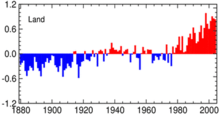Global surface temperature
In earth science, global surface temperature (GST) is calculated by averaging the temperature at the surface of the sea and air temperature over land. In technical writing, scientists call long-term changes in GST global cooling or global warming. Periods of both have happened regularly throughout earth's history.

Since the beginning of global temperatures in 1880 up to 1940, the average annual temperature has increased by 0.2 °C. The temperature was then stable between 1940 and 1970. And it has been increasing again since 1970 by 0.18 °C each decade. The average global temperature has increased by 0.9 °C (1.5 °F) compared to the baseline temperature[2] which is about 14 °C. Although a pause has been observed between 1998 and 2013, the global warming continues since at the same pace as before.
Background
In the 1860s, physicist John Tyndall recognized the Earth's natural greenhouse effect and suggested that slight changes in the atmospheric composition could bring about climatic variations. In 1896, a seminal paper by Swedish scientist Svante Arrhenius first predicted that changes in the levels of carbon dioxide in the atmosphere could substantially alter the surface temperature through the greenhouse effect.[3]
Changes in global temperatures over the past century provide evidence for the effects of increasing greenhouse gasses. When the climate system reacts to such changes, climate change follows. Measurement of the GST is one of the many lines of evidence supporting the scientific consensus on climate change, which is that humans are causing warming of Earth's climate system.
Warming oceans
With the Earth's temperature increasing, the ocean have absorbed much of this increased heat, with the top 700 meters of ocean showing warming of 0.22 C (0.4°F) since 1969.[3] Expansion of the warm water, along with melting ice sheets, causes the sea level to rise.
Shrinking ice sheets
The Antarctic and Greenland ice sheets have decreased exponentially in mass. According to NASA's Gravity Recovery and Climate Experiment, it shows that Greenland has lost an average of 286 billion tons of ice per year.[3] Expansion of the warm water, along with melting ice sheets, causes the sea level to rise.
See also
References
- "Highlights of Climate Change Impacts in the United States" (PDF). globalchange.gov/. U.S. Global Change Research Program. 2014. Retrieved 14 November 2019.

- World of change: Global Temperatures The global mean surface air temperature for the period 1951-1980 was estimated to be 14°C (57°F), with an uncertainty of several tenths of a degree.
- "Climate Change Evidence: How Do We Know?". Climate Change: Vital Signs of the Planet. NASA.
